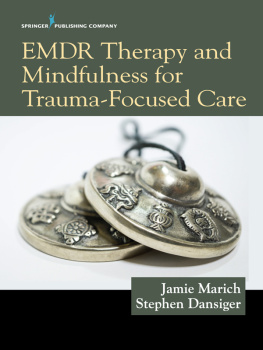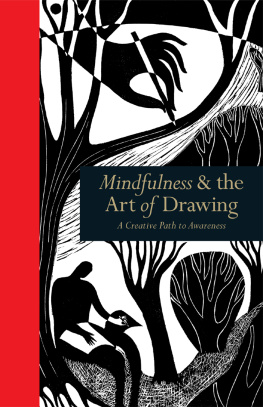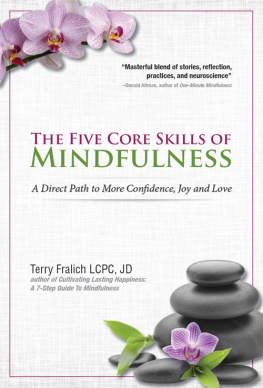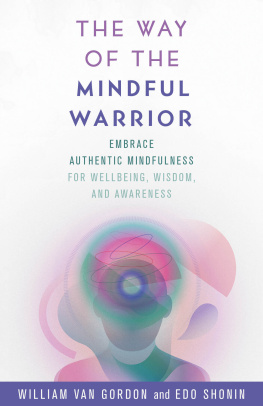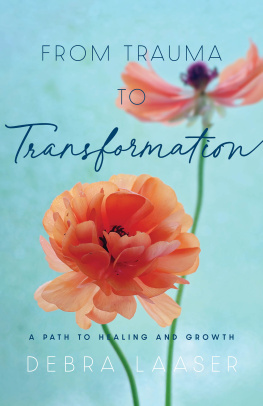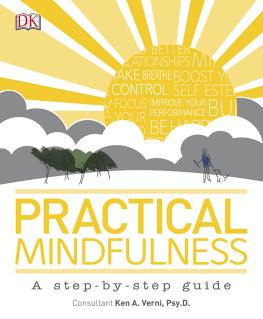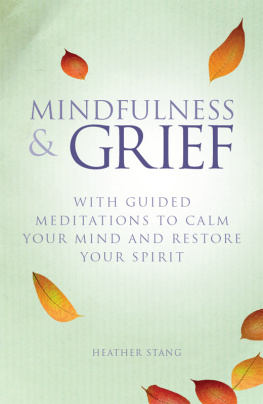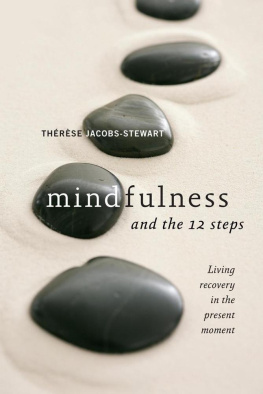
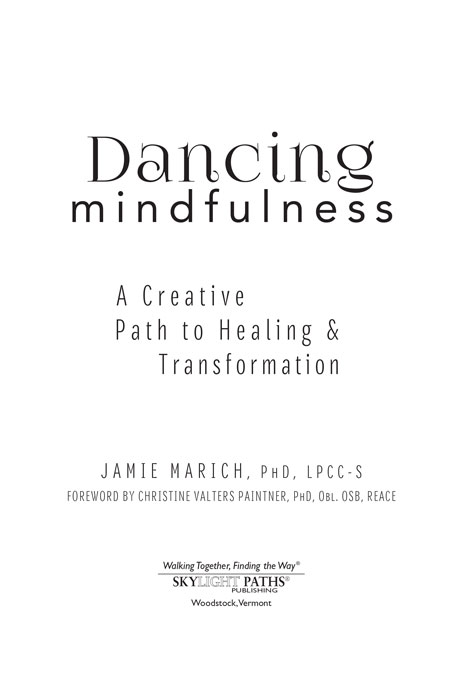
Thank you for purchasing this SkyLight Paths eBook!
Sign up for our e-newsletter to receive special offers and information on the latest new books and other great eBooks from SkyLight Paths.
Sign Up Here
or visit us online to sign up at
www.skylightpaths.com.
Send Us Your Feedback
Click here to send us your feedback and be entered into our quarterly drawing for a $100 gift certificate for SkyLight Paths books.
I dedicate this book to the first formally trained class of Dancing Mindfulness facilitatorsthank you for asking me to put this all down on paper and train you eleven amazing ladies! Its because of you that the practice is growing into what it is. Dance on!
In memory of Linda Johnson (d. 2014), a proud, glowing member of the first Dancing Mindfulness training class. Linda embodied the concept of dancing her joy, and she touched all of us who had the privilege of training with her during that first class. I look forward to the glorious day when we can dance again together on the other side!
Contents
Sign Up for Email Updates
Send Us Your Feedback
Foreword
Christine Valters Paintner
I first got to know Jamie and her work when I found her Dancing Mindfulness website online. For many years I have loved the power of dance to bring me back to the present moment and into the wisdom of my body. I have studied several practices of what is known as conscious dance, dance that doesnt have steps but is more an invitation into the organic and spontaneous movement of the body. These practices have included 5Rhythms, founded by Gabrielle Roth; SoulMotion, founded by Vinn Marti; BodySoul Rhythms, founded by Marion Woodman and Ann Skinner; and InterPlay, founded by Cynthia Winton Henry and Phil Porter.
These systems are all powerful and wonderfully complex. I was drawn to Jamies work for its simplicity and fundamental connection between movement practice and mindfulness meditation. When she offered her Dancing Mindfulness training in an online format, I took the opportunity to learn more from her, especially from her gifts as a trauma specialist. Jamie herself is full of the intelligence and compassion her work expresses. I deeply appreciated our conversations about the healing power of dance and ways to keep participants as safe and grounded as possible.
It was an even greater gift when Jamie attended a movement retreat I led called Coming Home to Your Body, and we got to dance together in physical reality, as opposed to just virtual reality. I delighted in her obvious commitment to her own practice and process, never shying away from the depth work of her own journey. This to me is a key indicator of the integrity and strength of a teacher: how much she or he is committed to doing their own inner work. Jamie offered much wisdom to our community; this arose from her own self-reflection and willingness to share her tenderness and moments of new awareness.
Jamies gift to the world in this Dancing Mindfulness work is an invitation and a portal into the practice of dance and movement as meditation. All bodies are welcome and all abilities. Anyone can dance, although many of us hold back because we dont look like dancers or because we have physical limitations. But I am willing to bet that most of you holding this book have touched a moment of transcendence or freedom in an experience of dance that leads you to explore deeper. You have a worthy guide in your hands.
Jamie elegantly weaves mindfulness principles into her practice so that anyone with a body might discover the grace and possibilities of this practice. The Buddhist writer Reginald Ray has a book titled Touching Enlightenment: Finding Realization in the Body , in which he describes the body as the last unexplored wilderness. I personally find this image very compelling, and Dancing Mindfulness offers a map into this place of wilderness and wisdom. Never rigid, always fluid, Jamie invites you to find your own dance, your own practice.

Introduction
The Art of
Dancing Mindfully
Dance, when youre broken open. Dance, if youve torn the bandage off. Dance in the middle of the fighting. Dance in your blood. Dance when youre perfectly free.
Rumi
W hat images do you associate with the word mindfulness ?
Do you see a fit yogi meditating on a beach in a perfect lotus position, entranced by the surrounding calm? Or do you picture a saintly Buddhist monk, eyes closed, clutching his prayer beads? Maybe you see a large group of people gathered at a festival, chanting Om in unison. You might even envision someone taking deliberate steps through a garden labyrinth, savoring each pace of a walking meditation. As mainstream as the practice of mindfulness has become in the last twenty years, our images of how to be mindful are still pretty clich. If you dont believe me, go to your favorite Internet search engine and type in the word mindfulness .
Heres a new image to try out: a dance floor full of people. Picture a community of people of all shapes, sizes, and physical abilities, each of them connecting their individual body, mind, and spirit through the simplest of rhythmic movements. A gathering of beings, getting down and grooving to every musical genre imaginable in one moment, and then shifting to the stillness of standing or sitting with an experience in the next. A collection of souls, each with their own unique story to tell, having fun and being themselves in the moment, tapping into the fullness of their human potential. This is dancing mindfulness.
What Is Mindfulness? What Is Dance?
Every human activity can be engaged mindfullyeating, stretching, breathing, walking, singing, praying, speaking, kissing, hugging, lovemaking, star gazing, and buying your groceries. So why not dancing?
There are a variety of ways to experience mindful awareness and to cultivate its practice. Mindfulness derives from the Sanskrit word smriti , meaning awareness. In a more nuanced translation, smriti means to come back to awareness. Jon Kabat-Zinn, a visionary who brings ancient mindfulness concepts to Western healthcare, simply defines mindfulness as paying attention in a particular way: on purpose, in the presence of the moment, and non-judgmentally. A yoga teacher I know puts the concept into even simpler terms during her class. The teacher invites us, in each pose, to be a witness, not a judge.
Like mindfulness, dance has been revered as an intrinsically healing art form by various cultures across the continents and across millennia of human existence. Dance promotes the building of community, is phenomenal physical exercise, and serves as a powerful communication medium. Yes, before there were Facebook groups, people used communal dancing as a way to gather and to learn about each other. This sacred art is still alive and well in many cultures and communities. Dancing is a coping skill for stress relief. Dance is a practice that native and indigenous cultures use, in lieu of talking, for total healing following a traumatic experience. Asian, Middle Eastern, and African cultures call upon movement, including certain types of dance, as a healing art form. Even traditional folklore in many European cultures incorporates these beneficial qualities. I would know, since such folklore provided my introduction to dancing!
Yet, in modern Western cultures, we tend to be inhibited when it comes to dancing. We fear that if we dont dance well we really shouldnt be dancing at all. We are victims of the looks are everything mentality. We do a whole lot of judgingof others and especially of ourselvesand not a lot of witnessing. What if we combined the beauty of mindful practice with nonjudgmental movement? Imagine the healing potential we could realizefor ourselves as well as in our roles as helping professionals working in community or clinical settings. Tapping into our potential for movement, creating beauty, and achieving mindful awareness defines a dancing mindfulness practice. Through such a practice we learn to respond to the needs of our body, mind, and spirit. Responding to these needs, instead of reacting compulsively or withdrawing into isolation, leads to enhanced wellness, vitality, and clarity.
Next page

